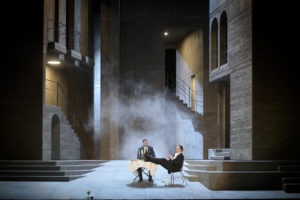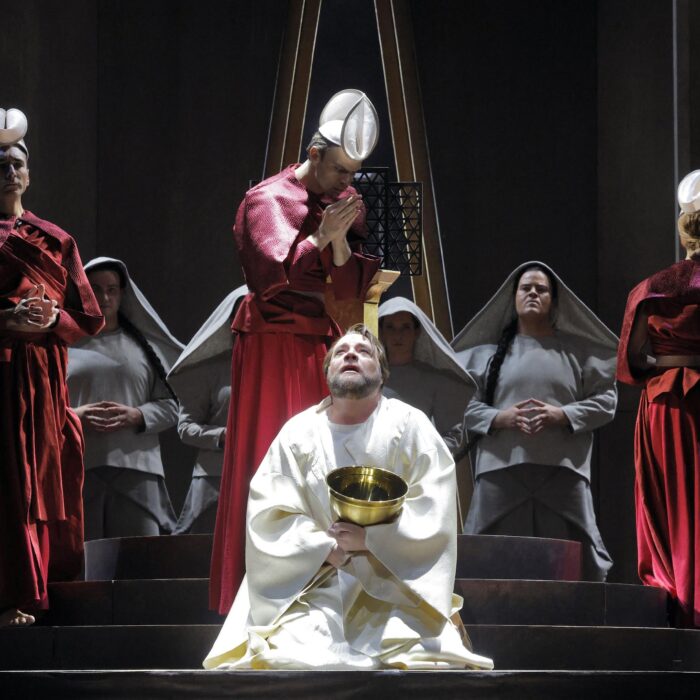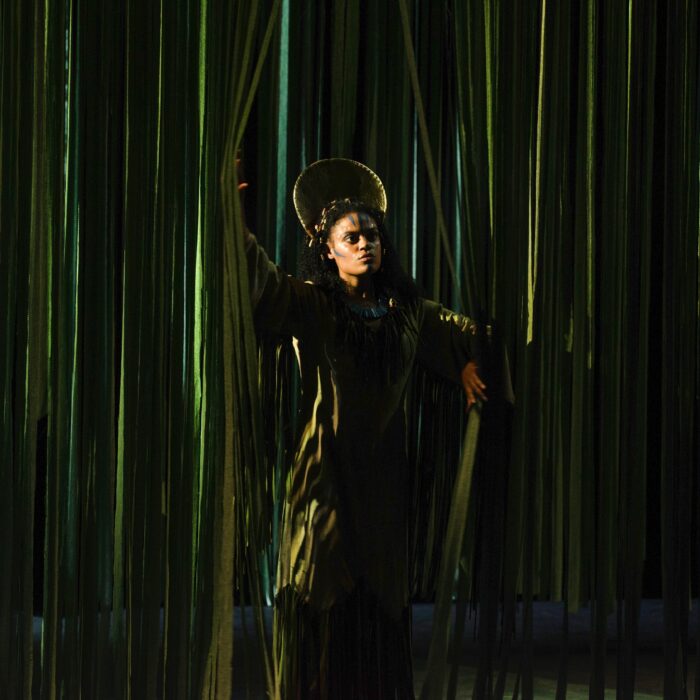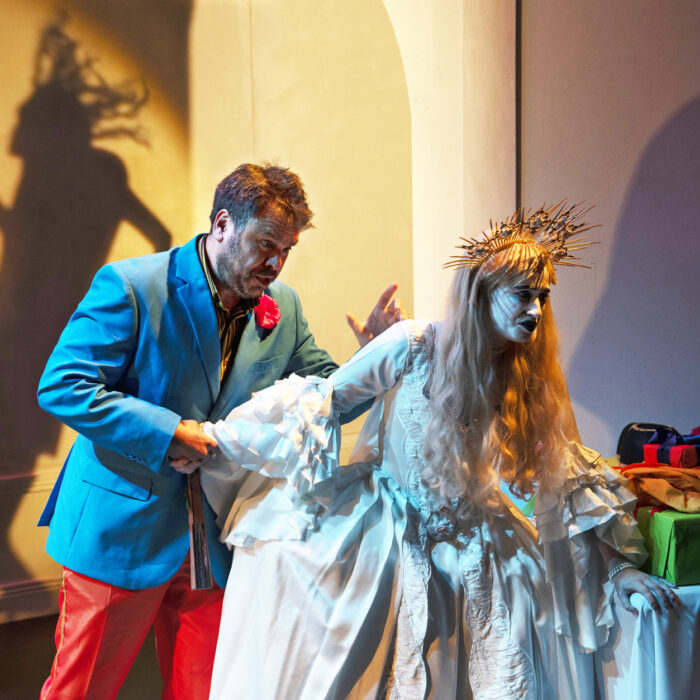
Metropolitan Opera 2025-26 Review: Don Giovanni (Cast B)
A Tremendous Cast Revives Mozart’s Masterwork
By David SalazarA new cast took over the Met Opera’s run of “Don Giovanni” on Nov. 6, 2025 to stunning results.
I’ve said this before, but casting is such a complex task in the opera world. Most of these productions have to be cast years before they take place and often rely on projections of where certain artists will be vocally and artistically in that matter of time. Moreover, even the most meticulous planning could implode due to a myriad of outcomes, including a shift in career trajectory, conflicting schedules, productions getting canceled, or simply last-minute illnesses. So to get a cast in which each singer not only fits a specific role, but fits a specific quality within the context of a cast of other singers bringing their own specific qualities to their specific roles, is nothing short of a miracle. This cast was one such instance.
Contrasting Forces
It all starts with the titular character himself. Kyle Ketelson has a robust baritone, but it’s also a delicate one all the same, allowing him to play up the contrasts of the central figure of the drama. He could blast out his sound during the opening trio of the opera, engaging in splendid vocal sparring with Guanqun Yu’s Donna Anna, or scale it back to a honeyed sweep on “Signorina” as he unknowingly attempts to console Donna Elvira. He could be more prickly in his recitativo exchanges with Leporello, often bursting out into violent shouts. Or he could imbue a more delicate touch as he plays the gentleman and not so subtly threatens Masetto. “Là ci darem la mano” was sung with tender legato line. There was roundness in every line, a beautiful softness and gentleness that didn’t betray any crudeness. The same could be said for the Act two “Deh! vieni alla finestra” where Ketelson leaned into the elegance in his sound. Where most interpreters do the repeat with a piano sound, here Ketelson added some ornamentation, but retained the fullness of his sound, allowing the piece to have a sense of continued drive and momentum. Instead of bringing attention to the interpreter luxuriating in Mozart’s music, this choice felt like it emphasized Giovanni’s growing desire in the context of the narrative. Meanwhile, “Fin ch’han dal vino” was pure bravado singing with Ketelson always in control of the quick tempo. Every single word was delivered with clarity and sounded brilliantly projected into the space. It’s a difficult piece, but Ketelson made you feel like he, as Giovanni, was having a blast. It wasn’t only his sound getting this kind of detail, but also his body language. From exuding strength and even pumping his chest during the confrontation with the Commendatore, to being more snake-like during the quartet as he gaslights Donna Anna, Donna Elvira, and Don Ottavio. He shifted from being smooth with Zerlina in “Là ci darem la mano” to being far more lecherous during the party, almost as if he’d drunk a few too many.
One of the baritone’s most potent moments was in the finale of Act one where Giovanni is cornered by his enemies and has nowhere to go. The tempo was brisk and again, Ketelson didn’t miss a beat, marching forward with technical precision and potent sound. The standout moment for Ketelson, though, had to be the opera’s finale, his voice at its most aggressive during interactions with Leporello. He’d been building this aggression throughout with each confrontation between master and servant increasingly hostile, the two shouting at each other in recitatives. So to see him so openly hostile felt like a natural progression. He wolfed down swaths of pasta like some animal. It drew laughs, but his savage body language here drew a far more interesting and nuanced picture. There was desperation, something that felt even clearer during his final scene with Donna Elvira, where Ketelson was equally brutal. All the tender sounds from earlier in the opera were nowhere to be found here. He was cruelty embodied, and his singing, pointed and aggressive, furthered this notion. This was a man who knew his time had come and he no longer had to hide who he was, allowing his base instincts to take over. In the final confrontation with the Commendatore, Ketelson let loose, his singing at its riveting here. If the opening of the opera could be seen as “vocal sparring,” here it was a full-on battle between Ketelson and Soloman Howard, who delivered a touchstone performance as the Commendatore. Not only did Howard deliver a round and even sound throughout his register, but he managed a consistent stream of power into the auditorium without any sign of strain. He embodied omnipotence to a tee; the sound itself seemed freed by the massive torrents of sound the orchestra was producing in this moment. In the context of the scene, his gloriously overwhelming sound was a perfect obstacle for Ketelson’s Don Giovanni, who, despite his ferocity and desire to continually fight back vocally, never stood a chance. This is what I mean when I say the casting was masterfully complementary.
Not to be overlooked was Tommaso Barea, in his Met Opera debut, as Leporello. Barea’s voice was a perfect contrast to Ketelson’s. Where the Don Giovanni interpreter had an ample, robust, and round sound, Barea’s was far more nimble with a darker, more rugged quality. He managed a strong debut as Don Giovanni’s resentful sidekick, showcasing great vocal versatility, particularly during patter sections. The first half of “Madamina, il catalogo è questo” was as fun as you’d expect, with the bass-baritone dish off one line after another with ease and a big smile on his face. The second half wasn’t as comfortable as the tempo seemed a bit slow (more later), but Barea managed more roundness in his sound here, particularly on “È la grande maestosa.” The contrasting “La piccina e ognor vezzosa” was delivered with exaggerated consonants, eliciting well-deserved laughter from the audience. He seemed intent on matching Ketelson’s vigor in their arguments, particularly in “Eh! Via buffone,” ending the duet by marching off all the way upstage and out of view. When Don Giovanni offered him some cash, Barea’s Leporello raced back toward him to get the gold. Speaking of which, he was comedic gold throughout the ensuing trio with Elvira, exaggerating Giovanni’s gestures while looking completely out of his depth throughout. He played up this weakness throughout the sextet and “O statua gentilissima.” In Barea’s hands, Leporello’s sense of increasing weakness and vulnerability continued throughout the finale of Act two where, despite his attempts to outwit his master or even imitate him, he was simply bested. Throughout the monumental confrontation with the Commendatore, Barea’s pleading patter provided a perfect counterpoint to the titanic showdown between the other two forces. At the close of the opera, he shared a tender moment with Elvira, consoling her as Ottavio and Anna sang of their future together. But just when you thought there might be something there, Elvira jumps up and rushes to declare herself to a convent. In all, this was a successful debut for Barea, and his stage presence and vocal charm made for a memorable interpretation of Leporello.
Paul Appleby’s Don Ottavio, like much of the music written for him, was the gentleman among the group, in the literal sense of the world. His “Dalla sua pace” was delivered with tender piano during the first verse, with a very subtle crescendo on the D natural into G on “morte mi da.” “S’ella sospira, sospiro anch’io” had a bit more force behind it, but it was subtle, the tenor retaining his delicate temperament. The reprise of the “Dalla sua pace” was softer still, though the final crescendo on the “Morte mi da” was more emphatic and the high G somehow softer. “Il mio tesoro” was similarly tender, the tenor dispatching the coloratura runs with agility. There was a feeling of increasingly muscular singing as the aria progressed, but even this show of strength in the character never felt overwhelmingly aggressive the way Ketelson’s often did.
Most interesting were his scenes with Guanqun Yu’s Donna Anna, where it was clear that she was the driver. Her interpretation of the character had a raw edge that matched Ketelson’s Giovanni, making them, if not the most direct of adversaries, at least emotional and even spiritual ones. In that opening duet with Appleby’s Don Ottavio, her dark and cutting soprano dominated, his voice clearly providing support. In all their scenes together, he retained that gentleness, providing ample contrast for her potency. And what potency it was. Yu has performed in a wide array of repertoire from Verdi to Puccini to Leoncavallo, just to name a few. The voice has a metallic sturdiness combined with ample volume that easily cuts through the orchestra. She turns Donna Anna into a dramatic soprano role, especially in the most bombastic moments. This was seen throughout the first scene, where her soprano overrode Ketelson during their initial trio, and during the aforementioned duet with Appleby. “Or sai chi l’onore” was one of the highlights for her; the soprano’s voice pushed to its dramatic edge, the voice explosive throughout without ever sounding forced or pushed. The lengthy A’s on “cor” were goosebump-inducing in all the right ways. More importantly, there was a connected legato line throughout, maintaining a sublime balance between the darker and more aggressive colors and the overall shape of the music. She interpolated some higher notes in the second half of the aria, providing even more hair-raising effect to this bravura showcase. On the opposite end of the spectrum was the gentle piano singing that she elicited throughout “Non mi dir, bell’idol mio.” She had delivered some softer tones in the Act one quartet and the trio of the finale, but this was the most delicate she had displayed to that point. She let loose once again in “Forse un giorno il cielo ancora,” delivering the coloratura section with ease. Her voice crescendoed throughout this section, with the final notes of the aria showering the audience with impressive sound. She earned an appropriately massive applause in response.
Leading Ladies
Anita Hartig’s Donna Elvira was a perfect foil to Yu’s Donna Anna. It’s easy to play Elvira as hysterical and over-the-top. But with Donna Anna as explosive as she is throughout the opera, this approach threatens to make the opera’s music exhausting in its overzealousness. Hartig instead plays up Elvira’s dignity, not only in her physical portrayal, always regal in her movements, but also in the elegance and gracefulness of her singing. Mozart gives Elvira a lot of high notes, often even poking jokes at the character’s fanatical love for Don Giovanni. But Hartig’s approach to her singing was that evenness and connection. High notes, such as the high A flats on “che per mio scorno” in “Ah, chi mi dice mai,” for example, never felt disembodied from the rest of the phrase or overly accented. The connection between registers sounded consistent, which gave her singing a sense of polish. The tempo during “Ah! fuggi il traditor” was slow (perhaps too slow for my taste), but it allowed Hartig ample room for legato phrasing. Whereas most singers accent the dotted rhythms, Hartig took the breadth afforded her to connect those lines more. Instead of a explosion of fury, the aria came off as a plea, adding nobility and vulnerability to the character. The final coloratura run was dispatched with precision, furthering the sense of refinement in her characterization. Throughout the quartet, the softness of her singing that came to the forefront, providing a perfect contrast to Ketelson’s serpentine interjections. Where a lot of sopranos struggle in the upper reaches of the vocal tessitura, again Hartig managed it with finesse. The final aria, Elvira’s “Mi tradi quell’alma ingrata” was also notable for this elegance of phrasing, Hartig voice blossoming on the higher notes. But she wasn’t just a docile femme fatale. There was increasing desperation in the final moments with Don Giovanni as she pleaded with him to give up his lifestyle. While he became increasing violent toward her, she responded with a sharper edge in her voice. Her “Fermati scellerato!” upon finding Giovanni with Zerlina was similarly emphatic and jagged in its expression. Hartig’s characterization was ultimately successful in how her Donna Elvira seemed to strive for composure at every turn to try and hide the hurt eating at her from inside. It served as a perfect dramatic counterpoint to the other characters who were far more outward with externalizing their desires or thoughts.
Where Yu’s aggression externalized her lust for vengeance, Andrea Carroll’s Zerlina did not try to hide her sexual desire. In this production, her opening duet with Masetto ends with the two on the floor while everyone watches. Exhibitionism isn’t an issue for them. But then, when Giovanni shows up, Carroll’s interpretation suggests a subtle attraction that grows throughout “La cì darem la mano.” Even as she gently sang “Vorrei è non vorrei,” her glances toward Ketelson’s Giovanni revealed her attraction, and by the end of the seduction, she unleashed her voice on “Andiam,” with a beautiful diminuendo. The end of the duet ended just as the initial one with Masetto had, Zerlina willingly on the floor with Giovanni. Her two arias are where Carroll really made her mark. Throughout “Batti batti,” she chased Brandon Cedel’s Masseto, her voice alternating between forceful and more gentle, giving it a sense of playfulness. There was an animalistic quality to her physicality as she crawled toward him, slowly, winning him over with every phrase. The final coloratura passages were delivered with sensuality, Carroll singing each one into his ear, as if a whisper. There was a rawness to the interpretation, and Carroll’s interplay with Cedel throughout only added to the sexual tension, which was surprisingly (or unsurprisingly) absent with every other dynamic in the opera. “Vedrai carino” was even more sensual with Zerlina tending to Masetto’s wounds. Here Carroll imbued her voice with sweetness as she caressed Cedel slowly and delicately. Again, the combination of the playful yet docile physicality and the expansive legato singing (not to mention the text) created ample sexual tension between the two. But in other instances, Carroll played up the more rebellious nature of Zerlina, especially in the sextet where she’s among the quickest to attack Leporello. She picks up the gun and aims it at him. As Giovanni attempts to lure her away in the Act one finale, there was tremendous grit in how she fought him off and rushed away. Zerlina isn’t often the focus of “Don Giovanni,” especially given the monumental nature of Elvira and Anna’s characters, but Carroll certainly stood side by side with Yu and Hartig as a leading lady, giving a tremendous portrayal of her character.
As Masetto, Brandon Cedel was a hulking figure with a round sound that complemented Carroll perfectly. Physically, the two could not contrast more; he was among the tallest members of the cast, and she the shortest. But this only made their relationship all the more endearing as he gave in to her at every turn. In all, he would have come off as a dog that barks but doesn’t bite if not for the stage directions for “Ho capito, signor sì!” where Masetto abuses Zerlina, throwing her around in his anger. It gets so out of hand that the rest of the friends and family have to restrain him. Moreover, Cedel played up the aggression of this interpretation in his vocal rendition, the consonants given more bite and the phrase more accented. Given how early this aria is in not only the opera but also in our understanding of Masetto and Zerlina’s relationship, seeing him so violent toward her because he’s shifting the blame to her for a demand made by Don Giovanni, makes him a hard character to trust for the rest of the night. The fact that Zerlina repeatedly goes back to him suggests a toxic relationship in the making. Of course, all of the relationships in this opera are toxic, but the production’s main argument, that ridding the world of men like Don Giovanni, leads to the return of color, beauty, and growth. However, Masetto’s actions would suggest he belongs in that group, but the fact that he doesn’t end up punished at the end of the production but instead gets rewarded, contradicts the production’s thesis a bit.
Some Dramatic License
In the pit, Daniele Rustioni took on his first performance as Principal Guest Conductor. It wasn’t a perfect night by any means, with ensembles often feeling tentative and, especially in the opera’s opening trio between Donna Anna, Don Giovanni, and Leporello, messy and sloppy. During the Act one finale, the onstage brass players struggled in the most noticeable of ways. Violins in the Allegro section of the overture sounded a bit messy on certain sixteen note runs. Overall, tempi seemed to be a work in progress, sometimes slowing to a snail’s pace (the second half of Leporello’s “Madamina” immediately comes to mind) and the orchestra could feel a bit lax in moments of high tension (the overture’s opening D minor section felt a bit “soft” until Rustioni placed a stress on one of the chords at the apex of section featuring the rising chromatic violin runs). Donna Elvira’s “Ah, fuggi il traditor!” felt both slow and overly gentle.
BUT… and this is a bit but, none of that mattered because of how riveting it all was in the grander scope of the night. As I noted, some tempi were slow, but Rustioni compensating by going to the extreme in other situations. Donna Anna and Don Ottavio’s duet in Act one rushed by with intensity I rarely heard because of its momentum. The entire Act one finale balanced the extremes beautifully, with Don Giovanni’s “Fin ch’han dal vino” feeling electric and the ensuing trio “Protegga il giusto ciel” forward-moving and yet reflective and gentle. It all crescendoed to a fiendishly fast coda that was riveting and tense. The speed made me wonder if there would even be enough musical time for Don Giovanni to make his escape after Ketelson and Barea’s lightning-fast pattering throughout. Act two felt far better paced from the conductor with the crowning jewels coming in the Act’s final sections. The final scene, starting with Giovanni’s dinner all the way through the final notes, was as good as any interpretation as you could ask. My complaints about the orchestra’s rather tepid opening were counteracted with some of the fiercest and most cathartically aggressive playing during the confrontation between Giovanni and the Commendatore, matching the epic sound produced by Howard and the powerfully aggressive Ketelson. This might feel hyperbolic but experiencing this scene on this occasion reminded me that this climax is one of the greatest ever written, not only in an opera, but also film, play, novel, or any other narrative work of art. The orchestra, its conductor, and chorus (which finally gets a moment to shine) played a massive role in giving me that experience.
As for the production, I have already laid out my thoughts on the Met’s premiere of Ivo Van Hove’s take as well as my experience of this production in Paris years earlier. This experience was notably different than those because the liberties the performers took with it, which bodes well for its longevity. That said, if liberties are allowed with the staging, then something must be done about that eye sore of nothing happening during the overture. It’s one of the greatest opening to any opera and can certainly stand on its own in the darkness of the theater. But if you’re going to turn on the stage lights during that first D minor chord, then there’s an expectation from the audience that something is going to happen on stage. To simply strand our eyes there for the duration of the overture with no noticeable developments is to do a disservice to the audience and, perhaps more importantly, to the music. Discomfort might be the intention, but confusion is more likely the result. Either keep us in the dark or do something with the time and space. Otherwise this production remains gripping and fascinating and the choices made by individual artists make it exciting to witness and rediscover.


